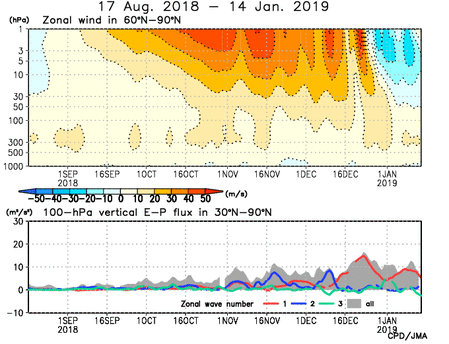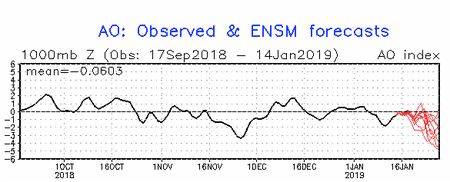Our group investigates climate impacts of the Arctic sea ice loss, especially on the mid-latitude winter. Here I introduce recently published paper, Hoshi et al., 2019, JGR-A. “Weak stratospheric polar vortex events modulated by the Arctic sea ice loss”.
In winter, circumpolar jet stream largely distorted as a response to large heat from the Arctic Ocean due to sea ice loss. Meandering of the jet stream, namely enhancement of the climatological planetary-scale wave, pushes cold airmass in the Arctic out to the mid-latitudes, bringing the frequent cold snap. Vertical coupling of the planetary-scale wave between the troposphere and the stratosphere enhances the meandering. Hoshi et al. (2019) showed that the Arctic sea ice loss induce wave number 2 type of the meandering (split of the polar vortex), which is more preferable for the vertical coupling than the wave number-1 type (displacement of the polar vortex). Consequently, mid-latitude cold winter is observed more frequently during low sea ice years.
Coincidentally, now (15th January) we have observed strong negative anomaly of the circumpolar jet stream in the stratosphere, known as “stratospheric sudden warming, SSW”, due to enhancement of the planetary-scale wave (Fig.1). A time scale of the stratospheric variations is about several weeks. Thus, we expect frequent cold snap during the next several weeks. An ensemble prediction of AO index published by NOAA also shows negative tendency, corresponding to increase of mid-latitude cold snap. On the other hands, it should be noted that in this year El-Nino, which often brings warm winter over Japan, is breaking out. Also, in this time wave number-1 is dominant rather than wave number-2, thus vertical coupling might be suppressed than expected.
Although there are various reasons for causality of individual cold snap event, in this time our study is consistent with predictions associated with the stratospheric sudden warming event. We further investigate the predictability through the tropical stratosphere, mid- and high-latitude ocean, and land processes. We expect our progressing studies will be useful for prediction studies.
Tetsu Nakamura (Hokkaido University, a member of theme 5)

Fig. 1 Seasonal evolutions of circumpolar zonal wind and vertical wave activity flux. It is depicted that enhancement of wave number-1 in the late December induces weakening of the stratospheric polar vortex, corresponding to the stratospheric sudden warming event. Figure is from JMA.

Fig. 2 Ensemble forecast of Arctic Oscillation (AO) index from NOAA. Black and red lines are observation-based value and forecast based on ensemble prediction. Negative tendency corresponding to increase of cold snap is predicted for the next two weeks.




